Disinformation
Infosecurity.sk: Bi-Weekly Report on Emerging Disinformation Trends (March 30, 2021)
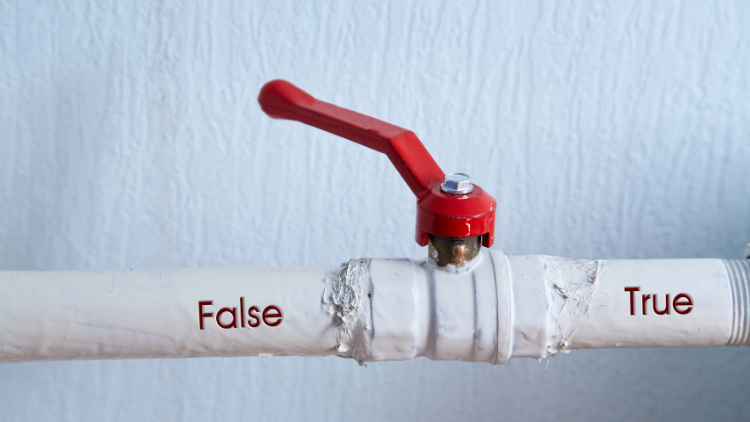
Project Infosecurity.sk organized by STRATPOL – Strategic Policy Institute and Slovak Security Policy Institute, supported by the Prague office of Friedrich Naumann Foundation for Freedom, continuously monitors the activities of both Slovak and foreign disinformation actors, but focuses mainly on the former. The project activities are built upon daily monitoring of emerging disinformation, hoaxes, and conspiracy theories in the online information space. That allows the analysts to identify disinformation posts and narratives that resonated with the public the most, as well as to find out where they originated, and how they spread and evolved on social media. This report represents a bi-weekly summary of arising trends in the spread of malicious information content online. Based on that, Infosecurity.sk can warn the public about emerging and current trends in the field of disinformation, manipulation, and propaganda.
In the last two weeks, Infosecurity.sk has managed to capture the following trends:
1. There has been a significant rise in disinformation narratives and hoaxes concerning the negative side effects of vaccination. Especially, a recent news report by the public broadcaster Radio and Television of Slovakia (RTVS) which falsely linked the death of a Slovak teacher to the side effects of AstraZeneca's vaccine, triggered a rise in disinformation narratives focusing on the side effects of vaccines
2. Disinformation actors focused on exploiting public concerns about the negative side effects of vaccines to shake and undermine public confidence in vaccination
3. Disinformation actors focused their criticism exclusively on vaccines from European and U.S. manufacturers while attributing only positives to the Russian vaccine Sputnik V
4. Disinformation actors also actively exploited the public´s fatigue and frustration with the ongoing pandemic measures, inciting public to disobey the measures and protest against the government
5. Statistics showed that disinformation websites in Slovakia successfully attracted the attention of social media users.
Exaggeration of vaccination side effects
From rumours that vaccines contain dangerous chemicals to absurd claims that vaccination is a secret plan to microchip humanity, hoaxes regarding vaccination have been spread on social media almost simultaneously with the vaccine's development.
In the past, conspiracy websites often spread "traditional" anti-vaccine narratives with the goal to discourage the public from all forms of vaccination. However, disinformation discourse has changed over time. It underwent a significant change after the Russian vaccine Sputnik V entered the market. In Slovakia, the rhetorical shift was most evident after the government decided to purchase the Russian vaccine.
Following the purchase of the vaccine by the Slovak government, local disinformation actors shifted their efforts almost exclusively to undermining trust in vaccines from "competing" manufacturers. These were portrayed predominantly in a negative light, while only positive attributes were ascribed to Sputnik V. Therefore, the disinformation media's goal shifted from generally discouraging the public from all forms of vaccination to discouraging them only from certain vaccines - particularly those coming from the EU and the U.S. manufacturers.
These narratives sought to undermine the general public's trust in Western vaccines by fuelling feelings of uncertainty and fear. This was done by repeating and exaggerating individual (often false) cases of negative side effects that resulted from vaccination.
The issue of negative side effects is a very sensitive topic for the Slovak public. A survey conducted by Median SK in December 2020 showed that as many as 76% of respondents in Slovakia feared side effects after the Covid-19 vaccination.
Thus, the issue of vaccine´s safety provides a valuable opportunity for the disinformation actors to incite fear of vaccination and undermine the credibility of the EU institutions.
To add fuel to the fire of disinformation, on March 12, Slovak public television RTVS broadcasted a news report titled: "death after vaccination in Slovakia." In the news report, a 38-year-old Slovak teacher's death was falsely linked to vaccination by AstraZeneca's vaccine. After the broadcast, the false information began to spread on the Internet as a hoax, which significantly increased the trend of questioning vaccines' safety.
Shortly thereafter, disinformation sites published a multitude of articles exaggerating side effects following vaccination with the AstraZeneca vaccine or even presenting other, fictitious cases of severe health consequences and even deaths following vaccination.
Although the Slovak Office for Health Care Supervision later claimed that the information was false according to autopsy results, the broadcast report managed to cause panic and attracted the general public towards disinformation narratives spread frequently by local pro-Russian media.
These disinformation actors, whose articles are repeatedly criticised for their lack of reliable sources, did not hesitate to seize the opportunity to legitimise their false claims by citing information from the usually trustworthy public broadcast station. Consequently, the conspiracy websites have automatically begun to link the death to AstraZeneca's vaccine, with the references to the flawed news report fitting neatly into their disinformation narrative.
An article published by the Slovak disinformation website Hlavné správy actively sought to stir up the Eurosceptic feelings by presenting a narrative that the EU's true intention is not to protect its member states' citizens but to play a geopolitical game against Russia.
The author backed up these false claims with a statement that the European Medicines Agency (EMA) approved AstraZeneca's vaccine, which, according to the disinformation narrative led to death after use. The author of the article did not forget to mention that the Sputnik V vaccine, which he considers the safest, has not been approved by the EMA so far.
The example of the RTVS's misleading news report represents a frightening example of how easily conspiracy websites can misuse such errors to undermine trust in the vaccination process, thus endangering the health of the general public. The fact that the disinformation media has benefited from the media turbulence surrounding AstraZeneca is also shown by the data gathered with the use of the analytical tool CrowdTangle[1].
As many as 4 of the 5 posts regarding the AstraZeneca vaccine which achieved the highest number of Facebook interactions (reactions, comments and shares) in the last 14 days come from pages known for spreading problematic content.
The first three posts that scored the highest number of interactions come from personal profiles of extremist politicians. Ľuboš Blaha is a far-left Slovak politician known for spreading pro-Russian propaganda and disinformation. Tomio Okamura is a far-right Czech politician who is also known for spreading problematic content. Milan Uhrík is a Slovak far-right MEP, also known for his extremist views. On the 4th place there is a post made by the Czech conspiracy page Otevři svou mysl. A Facebook post made by the Ministry of Health of the Slovak Republic, which is the only one on the list that contains reliable information about the vaccine, places behind all the disinformation actors in the total number of interactions.
We obtained data by searching for the keyword "AstraZeneca".
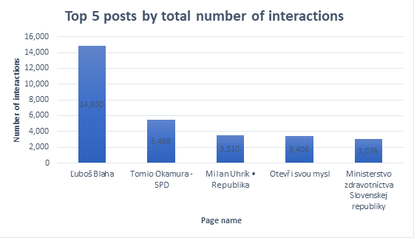
Undermining of pandemic measures
In recent days, the disinformation media has also sought to capitalise on the public's frustration and fatigue with the nearly year-long pandemic control measures. The theme of epidemiological measures resonated in society again following the government's recent decision to further extend the state of emergency.
The news was immediately picked up by the disinformation media, which paid excessive attention to protests abroad against the pandemic measures in their articles. These articles used suggestive rhetoric, trying to persuade readers not to comply with the government's pandemic measures and protest against the government.
The authors deliberately drew attention to the upcoming protest against the Slovak government, allegedly scheduled for March 30, despite the ongoing pandemic restrictions.
Of the individual disinformation actors, the aforementioned extremist politicians drew particular attention. Ľuboš Blaha utilised populist rhetoric to describe the measures as subjugating the weakest to the will of the millionaires. Similar language was used by Milan Uhrík, who described the state of emergency as a form of “blackmail”.
Both politicians have concealed the main reason for these measures, namely the fact that Slovakia is currently in the most critical phase since the beginning of the pandemic and is one of the worst countries in the world in numbers of Covid-19 hospitalised patients.
The long-lasting pandemic has a significant negative effect on the overall mood in society. In its frustration, the public is increasingly clinging towards extreme opinions. An example of this is the graph below which was created by using the data from the tool CrowdTangle.
The graph lists the top 5 Facebook posts by page, which received the highest number of interactions. All of those posts talked about the pandemic measures and the extended state of emergency.
The first three posts with the highest number of interactions come from the aforementioned Slovak politicians, Ľuboš Blaha and Milan Uhrík. The 4th place is occupied by the Slovak ex-PM Robert Fico, who has also undermined the pandemic restrictions on several occasions. A post made by the current Slovak minister of defence, Jaroslav Naď, ranked last out of the top 5.
We obtained the data based on a keyword search for "measures".
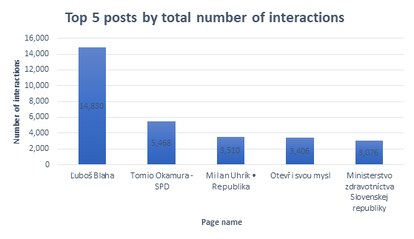
To further illustrate the strength of the Slovak disinformation actors on social media, we prepared three graphs.
For comparison, we selected three most relevant Slovak disinformation Facebook pages in terms of a number of followers: Hlavné Správy, Hlavný denník and ExtraPlus. We then compared their number of interactions with the number of interactions of three leading credible Slovak media Facebook pages: Aktuality.sk, Denník N and SME.
Although the three selected credible media pages have a total of 772.6 thousand followers on Facebook and the disinformation media have only about 97.6 thousand, the number of interactions that the disinformation media achieved in the last 14 days is strikingly high considering their smaller number of followers.
This fact is illustrated in the following two graphs created based on the data from CrowdTangle.
In the first graph, we can see that the selected credible media reached a total of 602.6 thousand interactions on their posts in the last two weeks.
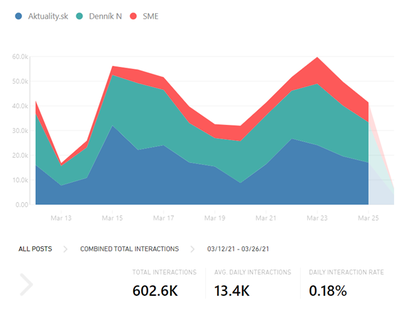
In the second graph, we can see that the selected disinformation pages scored a total of 308.1 thousand interactions in the same period.
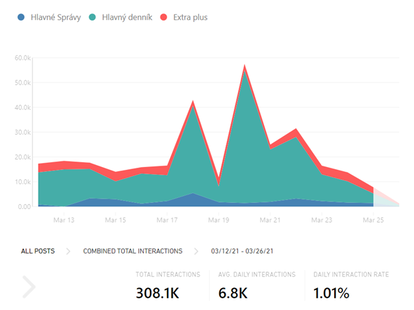
Although the disinformation media have almost seven times lower number of followers than the selected credible media, they reached almost half of the interactions of the credible media. Therefore, the obtained data indicates that disinformation actors in Slovakia have been particularly successful in attracting social media users' attention.
In the above charts showing the top 5 posts with the highest number of interactions, Ľuboš Blaha's blog consistently ranks first. For comparison, his blog has been long surpassing the three selected credible media in terms of interactions. The last 14 days were no exception as indicated in the following graph.
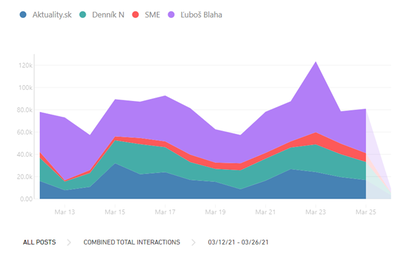
We recognise that statistics alone cannot comprehensively reflect the impact and actual influence of disinformation actors. However, they are able to provide us with valuable information regarding general trends and potential reach of some prominent disinformation sources. As indicated in the above graphs, the disinformation actors in Slovakia continue to be powerful players when it comes to attracting social media users´ attention. It is therefore important to keep in mind that spreading harmful disinformation represents an immense threat to the country's democratic society and should not be underestimated under any circumstances.
[1] Data from CrowdTangle, a public insights tool owned and operated by Facebook.
Matej Spišák is a Research Fellow at STRATPOL – Strategic Policy Institute in Bratislava and Editor-in-Chief at Infosecurity.sk.
Denis Takács is an Analyst at STRATPOL – Strategic Policy Institute in Bratislava.

